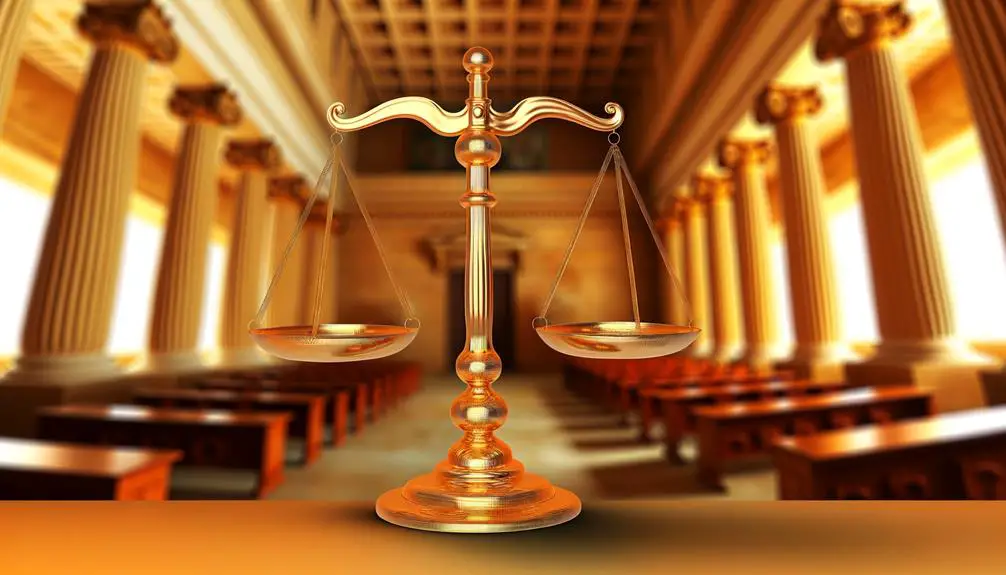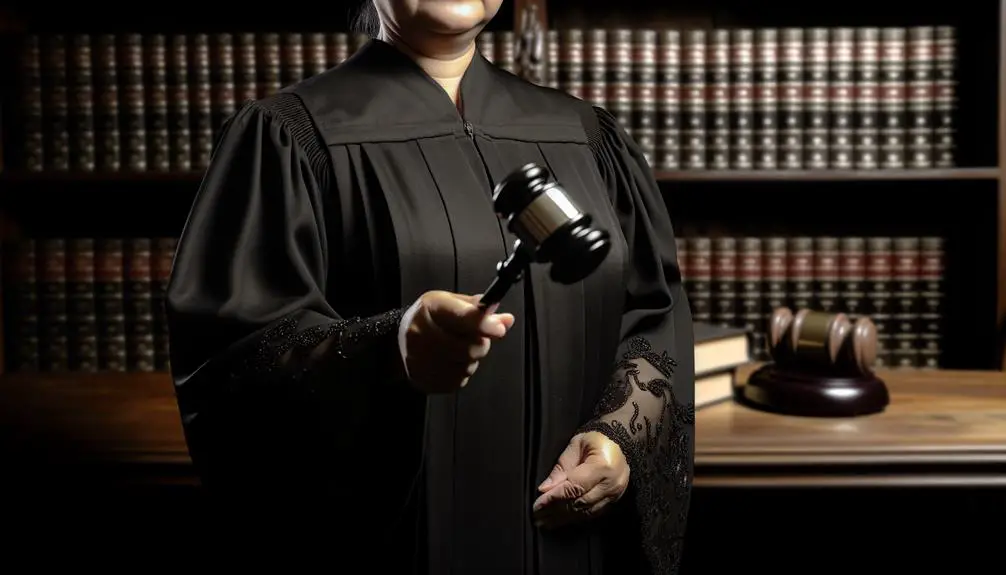Decoding Legal Symbols – A Guide to Understanding Their Meaning in Law
Symbols in law hold significant meaning, reflecting the core values and principles of the justice system. The Scales of Justice represent impartiality and fairness, ensuring balanced consideration of evidence.
The Gavel symbolizes judicial authority, order, and the conclusion of legal proceedings. Lady Justice, often depicted with scales and a blindfold, embodies equity and unbiased judgment.
Law books codify legal principles and facilitate consistency. Judicial robes signify impartiality, authority, and tradition.
Legal emblems in courtrooms communicate fundamental values such as fairness and the rule of law. By exploring these symbols, one gains deeper insight into the justice system's foundational values.

Key Takeaways
- The Scales of Justice symbolize impartiality, balance, and fairness in the legal system.
- The Gavel represents judicial authority, control over court proceedings, and the conclusion of trials.
- Lady Justice, with her blindfold, scales, and sword, embodies fairness, impartiality, and moral integrity.
- Judicial robes denote equality, impartiality, authority, and the continuity of judicial traditions.
- Legal emblems like scales, gavels, and Lady Justice communicate core values of justice, equity, and rule of law.
Scales of Justice

The Scales of Justice, symbolizing the impartial and balanced nature of the legal system, are a fundamental icon in the representation of law. These scales underscore the principle that justice should be meted out without bias or favoritism, reflecting an equilibrium between opposing arguments.
Originating from ancient Egyptian and Greek iconography, they serve as a visual metaphor for the judiciary's role in weighing the evidence and merits of a case. The scales embody the commitment to fairness, ensuring that each party receives equitable consideration.
This symbol reinforces the law's dedication to upholding justice, promoting trust in the legal system's ability to deliver unbiased decisions. Therefore, the Scales of Justice are integral to the conceptual framework of legal fairness and equality.
The Gavel

Frequently employed in courtrooms, the gavel is a powerful symbol representing judicial authority and the finality of legal decisions. This tool, often crafted from wood, embodies the judge's role in maintaining order and delivering justice. Its significance extends beyond its physical use; it carries deep symbolic weight in the legal system.
- Authority: The gavel signifies the judge's control over court proceedings.
- Finality: A gavel strike typically marks the conclusion of a trial or hearing.
- Order: It serves as a means to command attention and silence in the courtroom.
- Tradition: The gavel has historical roots in legal practices, symbolizing continuity and stability.
Understanding the gavel's role enhances comprehension of judicial processes and the solemnity of legal adjudication.
Lady Justice

Lady Justice, an enduring symbol in legal iconography, encapsulates the principles of fairness, equity, and impartiality. Originating from ancient mythology, her representation with scales and a blindfold serves to emphasize the objective and balanced administration of justice.
This discussion will explore the historical roots and symbolism of Lady Justice, focusing on her scales and blindfold, to elucidate their significance in the legal context.
Origins and Mythology
Rooted deeply in ancient mythology, the figure of Lady Justice symbolizes the enduring principles of fairness and moral integrity in the legal system. Deriving from the Roman goddess Justitia and the Greek goddess Themis, Lady Justice embodies a timeless representation of equity and judicial impartiality. Her mythology incorporates various aspects that continue to resonate in contemporary legal contexts:
- Blindfold: Denotes impartiality, suggesting justice should be meted out without regard to external influences.
- Sword: Represents enforcement and respect for the law.
- Scales: Symbolizes balance and the weighing of evidence.
- Robes: Indicate the solemnity and dignity of the judicial process.
These mythological elements collectively highlight the aspirational ideals upon which modern legal systems are founded, emphasizing objectivity and principled adjudication.
Scales of Justice
Among the various symbols associated with Lady Justice, the scales stand out as a prominent representation of balance and fairness in the legal adjudication process. These scales symbolize the weighing of evidence and arguments from all parties, ensuring that each side is given equal consideration.
The balance inherent in the scales underscores the principle that justice should be impartial and based solely on the merits of the case presented. In this instance, the scales serve as a metaphor for the judiciary's commitment to objectivity and neutrality.
Blindfold Symbolism
In the domain of legal iconography, the blindfold worn by Lady Justice symbolizes impartiality and the unbiased nature of judicial proceedings. This emblematic feature guarantees that justice is meted out without favoritism or prejudice, underscoring the principle that all individuals are equal before the law. The blindfold signifies:
- Neutrality: Decisions are made based on facts and laws, not external influences.
- Equality: Every party is afforded the same consideration, regardless of status.
- Objectivity: Emphasis is placed on evidentiary support, not appearances.
- Fairness: Guarantees that personal biases do not affect judicial outcomes.
In essence, the blindfold serves as a powerful reminder that justice must remain unswayed by personal or societal pressures, maintaining the integrity of the legal system.
Legal Seals

Legal seals, as traditional emblems of authenticity and authority, play an important role in verifying the legitimacy of official documents and ensuring their acceptance in legal proceedings. These seals serve as a crucial mechanism for maintaining the integrity of legal instruments, symbolizing the endorsement of a competent authority.
| Type of Seal | Function |
|---|---|
| Notary Seal | Verifies document authenticity |
| Corporate Seal | Confirms corporate decisions |
| Government Seal | Certifies official documents |
The use of legal seals has evolved but remains pivotal in modern legal systems for authentication and validation purposes. Their presence on documents signifies a recognized, binding commitment, reducing the risk of forgery and disputes. By serving as a tangible mark of verification, legal seals uphold the principles of trust and credibility within the legal framework.
Courtroom Flags

Courtroom flags serve as powerful symbols that convey authority and national identity. The colors, placement, and protocols associated with these flags are meticulously chosen to reflect the solemnity and order of the judicial process.
Understanding these elements enriches our comprehension of their role in reinforcing the principles of law and justice.
Symbolism of Flag Colors
The colors of flags displayed in courtrooms are imbued with symbolic significance that reflects the values and principles upheld by the legal system. Each color conveys distinct meanings that augment the gravity and solemnity of judicial proceedings. Specifically:
- Red often symbolizes courage and the blood of those who have fought for justice.
- White represents purity, truth, and the impartiality expected within the legal framework.
- Blue denotes vigilance, perseverance, and justice, embodying the steadfast nature of the law.
- Gold signifies honor and excellence, underscoring the high ethical standards demanded of legal professionals.
These colors collectively reinforce the foundational ideals of the judiciary, ensuring that the flag serves as a potent visual reminder of the law's integrity and authority.
Placement and Protocol
Proper placement and protocol for courtroom flags are crucial to uphold the dignity and decorum of judicial proceedings. The placement of flags in a courtroom is not arbitrary but follows stringent guidelines to guarantee respect for national and state symbols. Typically, the national flag is positioned to the judge's right, while the state flag is on the left. This configuration underscores the hierarchical precedence of national over state authority, reflecting the structure of federalism.
| Element | Position | Significance |
|---|---|---|
| National Flag | Judge's Right | Federal authority |
| State Flag | Judge's Left | State representation |
| Flag Height | Equal or higher | Symbolic equality or precedence |
| Cleanliness | Always maintained | Respect and decorum |
Understanding these protocols enhances the solemnity and reverence owed to judicial environments.
The Blindfold

Although often overlooked, the blindfold worn by Lady Justice serves as a powerful emblem of impartiality within the legal system. This symbol emphasizes that justice should be administered without bias or favoritism, ensuring that all are equal before the law.
The blindfold signifies:
- Objectivity: Decisions are made based on facts and law, not on appearances or external pressures.
- Equality: Every individual receives the same treatment in legal proceedings, regardless of status or identity.
- Neutrality: The judiciary remains detached from outside influences and personal prejudices.
- Focus: Concentration is directed solely on the evidence and legal principles.
In essence, the blindfold underscores the critical value of fairness, highlighting the judiciary's commitment to delivering unbiased justice.
Law Books

Law books serve as foundational texts that provide the fundamental legal rules, doctrines, and principles governing the administration of justice. These texts encompass statutes, case law, regulations, and scholarly commentary, forming the bedrock of legal education and practice.
Their significance goes beyond mere documentation; they symbolize the codification of societal norms and the pursuit of order. By meticulously detailing legal precedents and statutory interpretations, law books ensure consistency and predictability in judicial outcomes.
They also facilitate the continuous evolution of the law by serving as references for legal professionals and scholars. Essentially, law books are indispensable tools that embody the structured and systematic nature of legal reasoning, vital for maintaining the rule of law.
Judicial Robes

Just as law books symbolize the codification of societal norms, judicial robes represent the dignity, impartiality, and authority of the judiciary. These garments serve as a visual cue to the solemnity and gravity of judicial proceedings.
The symbolism embedded in judicial robes is multifaceted:
- Uniformity: They promote a sense of equality among judges, irrespective of individual differences.
- Impartiality: The robes' uniform color underscores the commitment to unbiased decision-making.
- Authority: The traditional design signifies the enduring power and respect commanded by the judicial office.
- Continuity: They link modern judicial practices to their historical roots, reinforcing the stability of legal traditions.
The judicial robe, thus, is not merely attire but a profound emblem of the justice system's foundational values.
Legal Emblems

Within the domain of law, legal emblems serve as powerful symbols that encapsulate the principles and authority of the legal system. Emblems such as the scales of justice, the gavel, and the Lady Justice statue are imbued with profound significance.
The scales signify balance and fairness, reflecting the impartiality imperative in legal adjudication. The gavel symbolizes judicial authority and order within the courtroom. Lady Justice, often depicted blindfolded, represents objectivity and the unbiased nature of justice.
These emblems are not merely decorative; they communicate the foundational values of justice, equity, and the rule of law. Their presence in courtrooms and legal documents underscores the gravitas and legitimacy of legal proceedings, resonating deeply within the jurisprudential framework.
Conclusion
The symbolism in law serves as the bedrock of legal tradition, embodying the principles of equity, authority, and impartiality.
From the steadfast Scales of Justice to the solemn gavel, each emblem narrates a tale of the judiciary's unwavering quest for fairness.
Legal seals and courtroom flags further underscore the gravity of legal proceedings, while Lady Justice's blindfold epitomizes objectivity.
Such symbols, etched in the annals of jurisprudence, fortify the pillars of law and enhance its solemnity.






